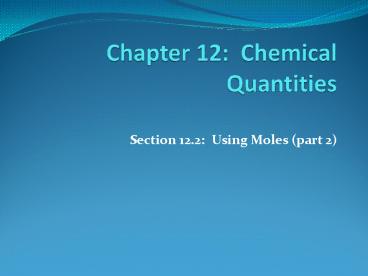Chapter 12: Chemical Quantities - PowerPoint PPT Presentation
1 / 19
Title:
Chapter 12: Chemical Quantities
Description:
Section 12.2: Using Moles (part 2) Remember Avogadro s Principle In terms of moles, states that equal volumes of gases at the same temperature and pressure ... – PowerPoint PPT presentation
Number of Views:105
Avg rating:3.0/5.0
Title: Chapter 12: Chemical Quantities
1
Chapter 12 Chemical Quantities
- Section 12.2 Using Moles (part 2)
2
Remember
- Avogadros Principle
- In terms of moles, states that equal volumes of
gases at the same temperature and pressure
contain equal numbers of moles of gases. - What is STP?
3
MOLAR VOLUME
- For a gas
- the volume that a mole of a gas occupies at a
pressure of one atmosphere (equal to 101 kPa) and
at a temperature of 0.00ºC STP - At STP, the volume of 1 mol of any gas is 22.4
L
4
Steps
- Vol A ? Mol A ? Mol B ? grams B
- 22.4 L Coeff.
Mass - OR
- Grams A ? Mol A ? Mol B ? Vol A
- mass Coeff.
22.4 L
5
Practice Problems
- 1) What mass of glucose (C6H12O6) must be broken
down in your body to produce 2.5 L of CO2 at STP? - C6H12O6 6O2 ? 6H2O 6 CO2
- 2.5 L CO2 x 1 mol CO2 x 1 mol C6H12O6 x 180 g
C6H12O6 - 22.4 L CO2 6 mol CO2
1 mol C6H12O6 - 3.35 g C6H12O6
6
Practice Problems (Cont)
- 2) What volume of oxygen is required to react
with 100 g of iron at STP? - 4 Fe 3O2 ? 2 Fe2O3
- 100 g Fe x 1 mol Fe x 3 mol O2 x 22.4
L O2 - 55.847 g Fe 4 mol Fe
1 mol O2 - 30.08 L O2
7
IDEAL GAS LAW
- Pressure P, volume V, temperature T, and the
number of particles n of gas are related by - PV nRT
8
IDEAL GAS LAW (Cont)
- R can be determined using the definition of molar
volume at STP - P 101.3 kPa
- V 22.4 L
- n 1 mol
- T 273.15 K
- (101.3 kPa)(22.4L) (1 mol)(R)(273.15 K)
- R (101.3 kPa)(22.4L) 8.31 kPaL
- (1 mol) (273.15 K) molK
9
- R is a constant 8.31 kPa . L
- mol . K
- If the given pressure is in kPa, use the value
for R above. If the given pressure is in atm,
then use the value - R .08205 atm . L
- mol . K
- If the given pressure is in mm Hg, then use
the value - R 62.36 mm Hg .
L - mol . K
- YOU WILL NOT HAVE TO MEMORIZE THESE!
10
- Do NOT let the algebraic formula get you! These
are all plug chug problems. ?
11
Practice Problem
- 1) How many moles of gas are contained in a 10 L
tank at 300 KPa and 500C? - PV nRT ? n PV/ RT
- 50273 323 K
- (300 kPa)(10L) n (8.31kPaL)(323K)
- molK
- n (300 kPa)(10L)
1.12 mol - (8.31kPaL)(323K)
- molK
12
Practice Problems (Cont)
- 2) What volume of gas is contained if 2 moles of
gas are at 20oC and 2 atm? - 2 atm x 101 KPa 202 KPa
- 1 atm
- PV nRT ? V nRT/ P
- 20273 293 K
- V 2 mol (8.31kPaL)(293K)
-
molK -
202 kPa - V
24.1 L
13
THEORETICAL YIELD
- The amount of product predicted to form is called
the theoretical yield - The actual yield is usually less than the
predicted (theoretical yield) - - Theoretical yield is determined through
calculation. - - Actual yield may be affected by the collection
techniques, apparatus used, time, and chemist
skills
14
- Efficiency of a reaction can be expressed as
percent yield - PERCENT YIELD actual yield x 100
- theoretical yield
- Manufacturers want to produce chemicals as
efficiently and inexpensively as possible
15
Practice Problems
- 1) What is the percent yield if the theoretical
yield is 4.5 g and the actual is 3.8 g? - yield 3.8 x 100
- 4.5
- 84.4
16
- 2) 10 g of H2 react with excess O2. When the
reaction is over 85 g of H2O are recovered, what
is the percent yield? - 2H2 O2 ? 2H2O
- Actual yield 85g
- 10 g H2 x 1 mol H2 x 2 mol H2O x 18.01
g H2O - 2.0158 g H2 2 mol H2
1 mol H2O - Theoretical yield 89.34 g H2O
- yield 85 g / 89.34 g x 100 95.14
17
Mass Percent
- Steps
- 1) Calculate mass of each element
- 2) Calculate total mass
- 3) Divide mass of element/ mass of compound
18
Mass Percent (Cont)
- Ex 1 Calculate the mass of C and H in C2H6
- 2 mol C x 12 g C 24 g C
- 6 mol H x 1 g H 6 g H
- Total mass C2H6 30 g
- C 24 g C x 100 80
- 30 g C2H6
- H 6 g H x 100 20
- 30 g C2H6
- Should add up to 100
19
Mass Percent (Cont)
- Ex 2 Calculate the mass of C, H, Br in C6H5Br
- 6 mol C x 12.011 72.066
- 5 mol H x 1.0079 5.0395
- 1 mol Br x 79.904 79.904
- 157.0095 g
- C 72.066 g C x 100
45.9 - 157.0095 g C2H5 Br
- H 5.0395 g H x 100
3.2 - 157.0095 g C2H5 Br
- Br 79.904 g Br x 100
50.9 - 157.0095 g C2H5 Br































